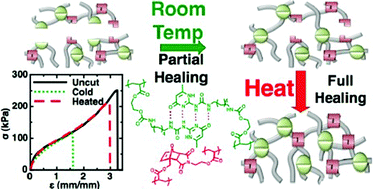Supramolecular interactions are defined as noncovalent bonds, including: hydrogen bonding, hydrophobic association, π-π stacking, transition metal complexation and ionic interactions. Supramolecular polymer networks consist of macromolecules which are interconnected through these transient noncovalent bonds. These materials are particularly interesting as they allow the capability of adaptive, self-healing materials which have mechanical properties that are dependent on the crosslinking interactions and the polymer topology. This month three articles are highlighted which demonstrate supramolecular interactions in polymer networks to give materials with interesting properties, such as self-healing, ductility and stimuli responsive changes in mechanical properties.
1. Self-healing, malleable and creep limiting materials using both supramolecular and reversible covalent linkages, Borui Zhang, Zachary A. Digby, Jacob A. Flum, Elizabeth M. Foster, Jessica L. Sparks, Dominik Konkolewicz, Polym. Chem., 2015, 6, 7368-7372.
The combination of supramolecular and reversible crosslinks was utilized to prepare materials with self-healing properties on different time scales. Supramolecular crosslinks between 2-ureido-4[1H]-pyrimidinone moieties gave dynamic crosslinks, whilst Diels-Alder coupling between a furan and a maleimide gave a considerably less dynamic linkage. The materials showed partial healing properties at room temperature and full healing at elevated temperatures.
2. Ultraductile, notch and stab resistant supramolecular hydrogels via host–guest interactions, Mei Tan, Yulin Cui, Aidi Zhu, Han Han, Mingyu Guo, Ming Jiang, Polym. Chem., 2015, 6, 7543-7549.
The authors describe the preparation of supramolecular hydrogels which were self-healing as well as extremely ductile and notch and stab resistant. The hydrogels were based on host-guest interactions between adamantane monomers and a low molecular weight polyfunctional cyclodextrin, prepared via free radical polymerisation. Native and healed gels gave similar tensile strain–stress trends, stretching to around 50 times their original lengths with almost complete recoverability.
3. Supramolecular polymer networks based on cucurbit[8]uril host–guest interactions as aqueous photo-rheological fluids, Cindy S. Y. Tan, Jesús del Barrio, Ji Liua, Oren A. Scherman, Polym. Chem., 2015, 6, 7652-7657.
Supramolecular polymer networks are reported based upon the host-guest interactions mediated by cucurbit[8]uril with naphthyl-functionalised hydroxyethyl cellulose, methyl viologen functional styrene copolymer and a photoisomerisable azobenzene imidazolium derivative. The resulting networks exhibited light-tunable rheological properties at low mass fractions (<0.75 wt%) showing a decrease in the zero-shear viscosity and viscoelastic moduli by UV irradiation.
Dr. Fiona Hatton is a Web Writer for Polymer Chemistry. She is currently a postdoctoral researcher at KTH Royal Institute of Technology, Sweden, having completed her PhD in the Rannard group at the University of Liverpool, UK. Visit her webpage for more information.











